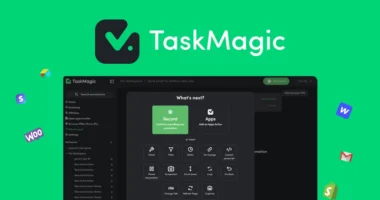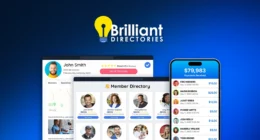Healthcare software marketing combines digital transformation strategies with targeted outreach to medical decision-makers. Successful campaigns leverage data analytics, compliance messaging, and multi-channel engagement through platforms like LinkedIn and healthcare conferences. Key elements include personalized communications, HIPAA-compliant security measures, and solutions addressing specific pain points in medical practices. CRM systems help track engagement metrics while AI-powered tools enhance marketing efficiency. Understanding these core components sets the foundation for developing thorough healthcare software marketing strategies.
Quick Overview
- Leverage data analytics and CRM systems to create personalized marketing campaigns targeting specific healthcare decision-makers and stakeholders.
- Demonstrate HIPAA compliance and robust security measures to build trust and credibility with healthcare organizations.
- Utilize multiple digital channels including LinkedIn, webinars, and healthcare conferences to maximize marketing reach and engagement.
- Partner with healthcare opinion leaders and create thought leadership content to establish industry authority and expertise.
- Address specific pain points like system integration, cost-effectiveness, and care coordination in marketing messages to resonate with healthcare providers.
Understanding the Healthcare Software Marketing Landscape

The digital tidal wave sweeping through healthcare has fundamentally reshaped how software companies market their solutions to medical professionals and institutions. The industry is experiencing unprecedented growth, with healthcare marketing expanding from $22.75 billion in 2024 to $24.55 billion in 2025.
This transformation is driven by three key factors:
- The shift to digital-first strategies, emphasizing online engagement and telehealth promotion
- Integration of AI-powered solutions for personalized patient outreach
- Growing reliance on data from wearables and digital health tools
Healthcare software marketers now focus on creating targeted campaigns that showcase accessibility, cost-effectiveness, and seamless integration. With over 64% of Health & Life Sciences companies recognizing AI’s importance, marketing strategies increasingly leverage artificial intelligence to optimize content delivery and enhance patient engagement through various digital channels. The adoption of advanced CRM systems has become crucial for centralizing patient data and delivering personalized communications that drive stronger engagement.
Key Strategies for Reaching Healthcare Decision-Makers
Reaching healthcare decision-makers requires a sophisticated, multi-layered approach that combines data-driven insights with personalized messaging. Successful marketing strategies focus on segmenting key stakeholders, understanding their unique pain points, and delivering targeted solutions through multiple channels. Engaging healthcare professionals during their personal digital time can create more authentic connections and increase message receptivity.
Strategic healthcare marketing demands both analytical precision and customized outreach to connect with decision-makers who drive industry change.
Essential components of an effective outreach strategy include:
- Using data analytics to map influencers and decision-makers
- Creating persona-specific content that addresses individual challenges
- Leveraging multiple communication channels, from LinkedIn to healthcare conferences
- Building credibility through thought leadership and partnerships with key opinion leaders
- Tracking engagement metrics and ROI through CRM tools
Building Trust Through Compliance and Security

While reaching decision-makers sets the foundation for healthcare software marketing, building lasting relationships hinges on demonstrating robust compliance and security measures. Organizations must prioritize regulatory adherence to standards like HIPAA, IEC 62304, and GDPR to establish credibility with stakeholders. With modern healthcare data breaches costing an average of $9.77 million, implementing strong compliance measures is essential for risk management.
Key trust-building elements include:
- Strong encryption methods and access controls for patient data protection
- Transparent compliance processes that demonstrate accountability
- Regular security monitoring and proactive risk assessment
- Integration with existing EHR systems while maintaining data security
Effective compliance tools support these efforts through:
- Automated policy management and updates
- Risk identification and resolution capabilities
- Chart auditing features for data accuracy
- HIPAA-compliant marketing practices
This thorough approach to compliance and security helps healthcare software providers build lasting trust while protecting sensitive patient information.
Leveraging Data-Driven Marketing Techniques
Modern healthcare software’s marketing success relies heavily on data-driven techniques that transform raw information into actionable insights. Through behavioral segmentation and demographic analysis, marketers can create highly targeted campaigns that resonate with specific patient and provider groups.
Organizations leveraging data analytics are seeing remarkable results, with reports showing they’re 23 times more likely to acquire customers and six times more likely to retain them. Key performance metrics, including website traffic and conversion rates, guide strategic decisions and budget allocation. Real-time feedback from multiple sources – EHRs, social media, and website analytics – enables continuous campaign optimization. Marketing teams use continuous buyer testing to refine their strategies and ensure alignment with organizational objectives.
Addressing Stakeholder Pain Points in Healthcare

Healthcare software providers face critical challenges in addressing diverse stakeholder pain points across the medical ecosystem. Successful marketing strategies must target specific obstacles while demonstrating clear solutions for healthcare organizations, practitioners, and patients. Understanding these pain points enables marketers to position their solutions effectively and build trust with potential clients. The prevalence of limited staff availability has made efficient software solutions increasingly vital for healthcare facilities.
Key challenges and solutions include:
- Seamless system integration that addresses interoperability challenges between different platforms
- Patient-centric communication tools that accommodate users of all technical abilities
- Care coordination solutions that streamline provider collaboration and reduce medical errors
- Cost-effective implementation options, including SaaS models for smaller practices
- Thorough training and support programs to overcome adoption barriers
Measuring Success in Healthcare Software Marketing
Building on the understanding of stakeholder pain points, measuring success in healthcare software marketing requires a systematic approach to tracking and analyzing key performance metrics. Organizations must monitor both immediate campaign effectiveness and long-term business impact through carefully selected indicators.
Core metrics fall into four essential categories: patient acquisition data like PAC and CLV, content performance metrics including website traffic and CTRs, technology integration success rates, and financial outcomes. Regular measurement of these indicators helps marketing teams optimize their strategies and demonstrate ROI to stakeholders. Marketing automation analytics provide valuable insights to help fine-tune communication strategies and improve overall campaign performance.
Success measurement also involves continuous improvement through A/B testing, customer feedback analysis, and user behavior monitoring. These insights enable healthcare software companies to refine their marketing approaches while ensuring alignment with both provider needs and patient care objectives.
Frequently Asked Questions
How Long Should Healthcare Software Pilot Programs Typically Run Before Full Implementation?
Healthcare software pilot programs typically run between 2 to 3 years before full implementation. This duration allows organizations to properly assess implementation feasibility, evaluate performance metrics, and address potential issues.
Complex systems, particularly those involving AI or multiple clinical settings, may require longer periods. However, simpler features or localized implementations might only need 3-6 months. The key is ensuring sufficient time to gather meaningful data and validate outcomes.
What Percentage of Healthcare Software Marketing Budgets Should Go to Digital Channels?
Based on current industry trends, healthcare organizations should allocate 50-60% of their marketing budgets to digital channels. This allocation reflects the increasing shift toward online patient engagement and digital healthcare delivery.
The remaining 40-50% can support traditional marketing channels to maintain a balanced approach. Organizations should adjust these percentages based on their specific target audience demographics, competitive landscape, and measurable ROI from previous digital marketing campaigns.
How Often Should Healthcare Software Companies Update Their Marketing Materials Post-Launch?
Companies should implement a structured update schedule for marketing materials post-launch.
Core content should be reviewed quarterly to incorporate industry trends and software updates. SEO elements need semi-annual optimization, while case studies and testimonials require annual updates.
Immediate revisions are necessary when significant product changes occur or new regulations emerge.
Brand messaging should undergo thorough evaluation every 2-3 years to guarantee market relevance and competitiveness.
Which Social Media Platforms Are Most Effective for Reaching Healthcare Technology Buyers?
While all social media platforms have value, LinkedIn and Twitter emerge as the most effective channels for reaching healthcare technology buyers.
LinkedIn’s professional network excels at connecting with decision-makers through detailed content and targeted advertising, while Twitter enables real-time industry discussions and quick updates.
Facebook can support broader awareness campaigns, and YouTube proves valuable for product demonstrations, but the B2B focus of LinkedIn and Twitter makes them particularly impactful.
What Role Do Medical Device Distributors Play in Healthcare Software Marketing?
Medical device distributors serve as essential intermediaries in healthcare software marketing by leveraging their established relationships with healthcare providers. They facilitate software adoption through their existing distribution channels, provide valuable market insights, and offer localized support.
These distributors often bundle software solutions with medical devices, creating extensive packages. Their deep understanding of healthcare facilities’ needs helps software companies refine their marketing strategies and improve market penetration.
Conclusion
Like a lighthouse guiding ships to shore, effective healthcare software marketing illuminates solutions for medical professionals charting complex technological waters. Through strategic targeting, compliance-focused messaging, and data-driven approaches, marketers can successfully connect life-changing software with healthcare decision-makers. Success in this specialized landscape requires a delicate balance of addressing pain points while building trust – ultimately improving patient care through innovative technology adoption.








